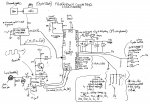Well, I drew the diagram before the weekend. Not in any fancy software, I thought I'd sketch it out first.
The input is a coax BNC arrangement, with 50 ohm impedance matching. I have also included a pair of back-to-back signal diodes for clipping if required.
We have the 40x2 in the centre - no crystal needed now as it's not going to be generating the timing nor gate, just counting. So it can run at 4 or 8 MHz.
There's the 28x1 generating the clock, initially I thought working off a 16MHz resonator (I don't have a 16MHz crystal). I understand it can go to 20MHz, but the picaxe software editor doesn't support this? I would generate a 10MHz PWMOUT signal. I don't think the 16MHz resonator will be accurate enough. Even the 20x2 internal 64MHz, perhaps won't cut it So, committing to crystal, I'll have to get one. The config is fairly easy as I understand; a couple of caps will be needed.
The prescaler is controlled by the 40x2. A user can select a rotary switch which divide by 10,20,40, or 80 - or not at all. Not sure how to do this as the raw signal would somehow have to bypass the pre-scaler, amplified to make sure it was 0-5V, and then passed to the picaxe. A 100MHz signal at say /20 is going to appear as 5MHz
The 74HC7408 would AND the 28x1 10MHz together and pass it to the timer pin C.0 on the 40X2. I chose a 7408 as it's HC and has very short propagation and transition times (~5ns) versus my 4081 (~100ns), with a max frequency of a couple of MHz. In theory I could crank up the voltage to speed it up towards 10MHz, then I'd need to amplify the signal a bit more etc... probably easier to just get a 7408 that runs around 25+MHz.
Then, it's a matter of getting the little 08M to generate a gate of say 0.5s. It would have been nice to use one of the other picaxes in the arrangement (above), but perhaps an 08M running at 8MHz will generate an accurate enough 0.5s? Your thoughts here would be good. It seems a little wasteful to use another 28x1 or 20x2 for this, if an 08M will do the trick. I half wondered if I couldn't generate a very accurate clock using logic gates etc, but then if I wanted to play around with the timing, that would be a lot more difficult than were it on a picaxe. Speaking of which, the diagram shows the timing controlled by the 40x2, it would in fact be the 08M. There's nothing else for the 08M to do, aside from the RESET (start counting) button.
Other thoughts / ideas you might want to comment on:
1. I've included 1K resistors from the 40x2 to the prescaler, to limit current. The 12080 might be high enough impedance I might to make these unnecessary. Easy enough to include them though.
2. I thought it might be useful (and easy) to have rotary switches that offered no or different pre-scaling, and up to 12 different gate times.
3. I've added 6 LEDs to indicate overange, prescaler is on or off, in auto-range mode, "busy" mode i.e. counting, and 2 to indicate whether the display is in MHz or kHz.
4. There could be an Auto-range button that when off could allow the user to select a number of pre-defined maximum ranges, e.g. 500, 100, 50, 10, 1 MHz, 500kHz, etc. Or, perhaps it would be able to auto-range so fast it wouldn't be worth doing this.
5. For the AND gate, and the picaxes - any unused inputs / outputs I was going to tie to ground.
I (we!) are making progress! Thank you for all your thoughts. Much appreciated.


